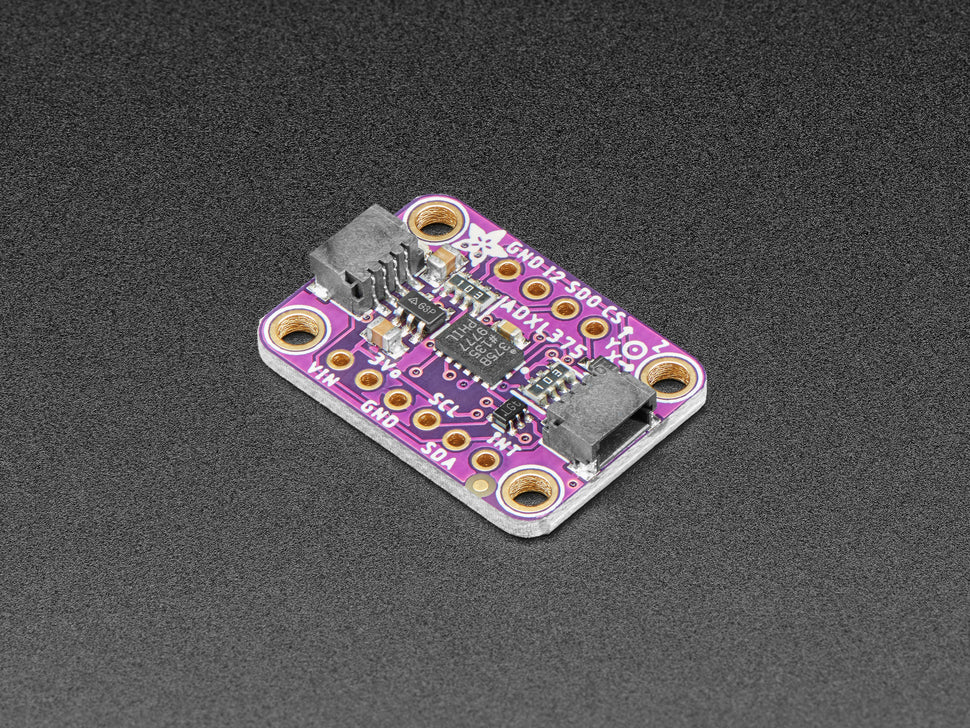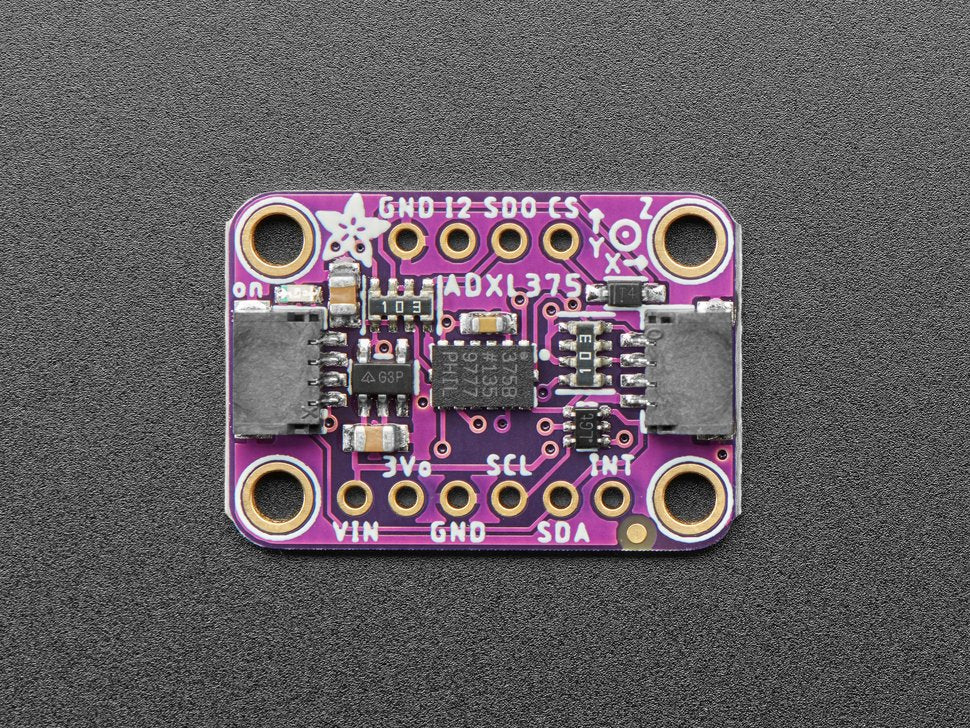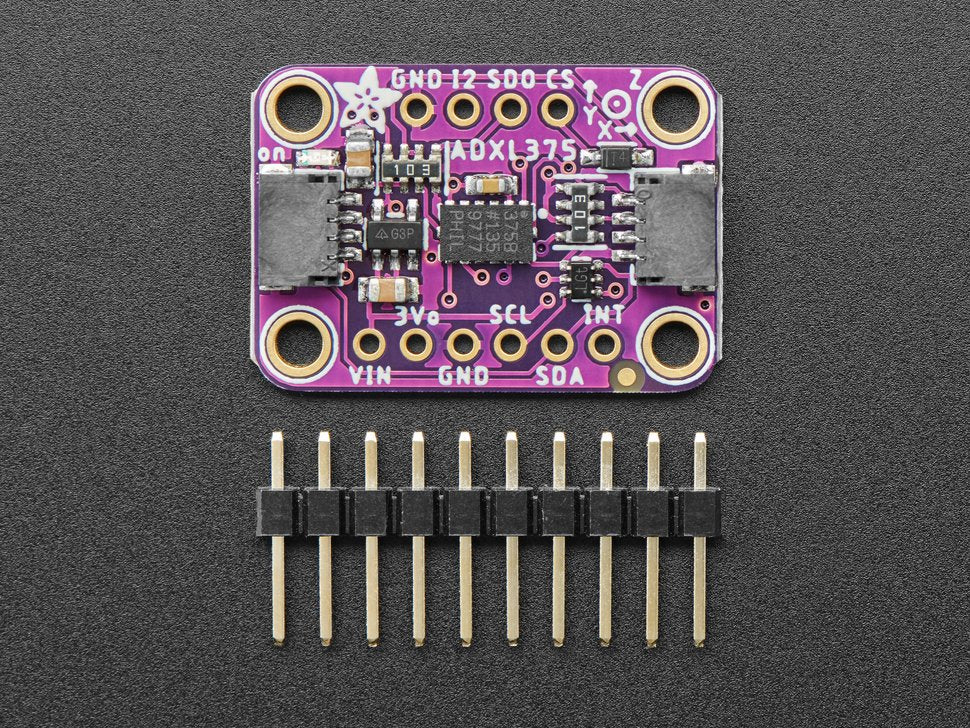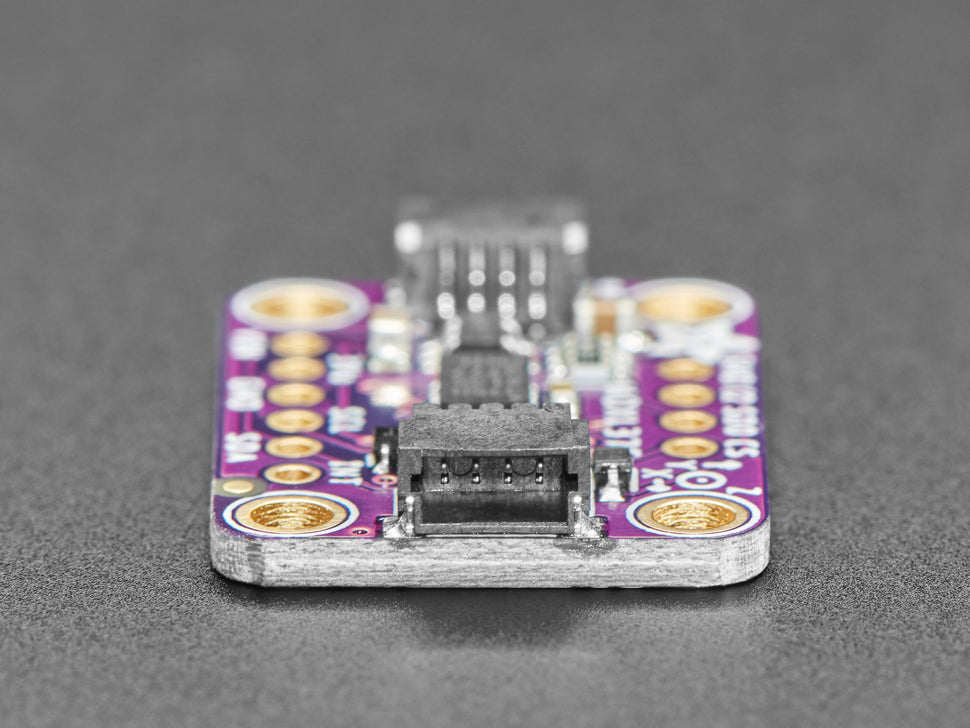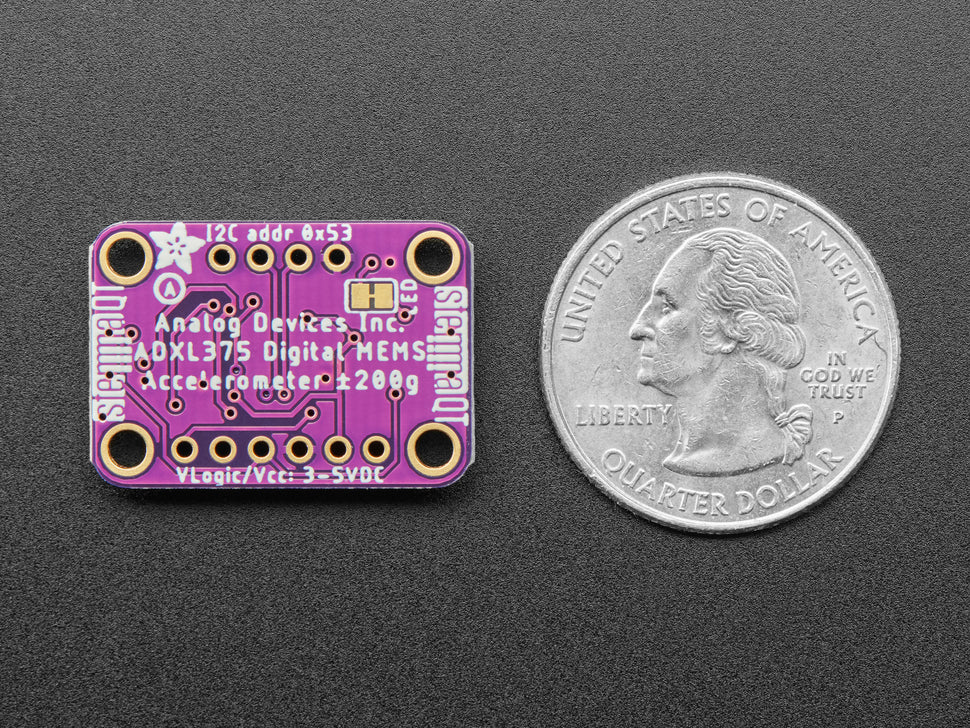Hey Raketenmann (brennt deine Sicherung da draußen alleine durch), hast du dich jemals gefragt, wie schnell du fliegst? Der Adafruit ADXL375 High G Accelerometer ist ein epischer +-200g 3-Achsen-Beschleunigungsmesser, der dir die Antwort geben kann.
Du hast richtig gelesen, dieser Beschleunigungssensor kann bis zu 200 g Kraft in drei Messachsen (X, Y, Z) messen und verfügt über Pins, die entweder als I2C- oder SPI-Digitalschnittstelle verwendet werden können. für eine einfache Integration in jedes schnelle Projekt. Die integrierte Bewegungserkennung macht die Stoßerkennung einfach zu implementieren. Es gibt zwei Interrupt-Pins, und Sie können jeden der Interrupts unabhängig auf einen der beiden Pins zuordnen. Unglaublich! Es überrascht nicht, dass Adafruit zu einem Breakout für diesen Sensor nicht "nein" sagen konnte.
Der ADXL375 sieht aus und verhält sich fast identisch zu seinen Spezifikationen wie die kleinen Schwestern ADXL345 und ADXL343. Diese haben nur einen Maximalwert von +-16g und einen einstellbaren Bereich. Dieser Sensor verhält sich genauso und sieht genauso aus, außer dass man den Bereich nicht ändern kann und er auf 200 g festgelegt ist. Wenn Sie also etwas anderes als Arduino oder CircuitPython verwenden, ist die Portierung ziemlich einfach, und Code, der für den '345/'343 geschrieben wurde, wird wahrscheinlich auch mit dem '375 funktionieren, wenn man nur die Skalierung anpasst.
Wie bei allen Adafruit-Breakouts ist dieser praktische Beschleunigungssensor super einfach zu bedienen. Adafruit hat ihn auf einem Breakout-Board mit den erforderlichen Schaltungen und Anschlüssen untergebracht, um die Arbeit mit ihm zu erleichtern. Da I2C unterstützt wird, sind SparkFun Qwiic-kompatible STEMMA QT JST SH-Stecker hinzugefügt worden, die es Ihnen ermöglichen, ohne Löten loszulegen. Verwenden Sie einfach ein STEMMA QT-Adapterkabel, schließen Sie es an Ihren bevorzugten Mikrocontroller oder Blinka-unterstützten SBC an und schon können Sie loslegen! Das QT-Kabel ist nicht im Lieferumfang enthalten.
Adafruit stellt sowohl Arduino (C/C++) als auch CircuitPython (Python 3) Bibliotheken zur Verfügung, so dass Sie es mit jedem Mikrocontroller wie Arduino, ESP8266, Metro, etc. oder mit Raspberry Pi oder anderen Linux-Computern dank Blinka (Adafruits CircuitPython Bibliothek Support Helper) verwenden können.
Jede Bestellung kommt mit einem vollständig getesteten und montierten Breakout und einigen Headern zum Anlöten an eine Platine oder ein Breadboard. 9-polige 0,1"-Standard-Stiftleiste für den Fall, dass Sie es mit einem Breadboard oder Perfboard verwenden möchten. Vier 2,5 mm (0,1") Montagelöcher für eine einfache Befestigung - in weniger als 5 Minuten sind Sie startklar!
English Description
Hey rocket man (burnin' out your fuse out there alone) ever wonder how fast you're rocketing? The Adafruit ADXL375 High G Accelerometer is an epic +-200g 3-axis accelerometer may be able to tell the answer.
You read that right, this accelerometer can sense up to 200 g's of force in three axes of measurements (X Y Z) has and pins that can be used either as I2C or SPI digital interfacing. for easy integration into any fast project. Built-in motion detection features make shock detection easy to implement. There's two interrupt pins, and you can map any of the interrupts independently to either of them. Incredible! Not surprisingly, we couldn't say "no" to a breakout for this sensor.
The ADXL375 looks and acts nearly identically to its in specifications to the little sisters ADXL345 and ADXL343. Those are only +-16g max, and have adjustable ranges. This sensor acts and looks the same except that you cannot change the range, and it's fixed at 200g. Otherwise, existing library code will 'just work' so if you happen to be using something other than Arduino or CircuitPython, the port is pretty easy and code written for the '345/'343 will likely work on the '375 with just a scaling adjustment.
As with all Adafruit breakouts, we've done the work to make this handy accelerometer super easy to use. We've put it on a breakout board with the required support circuitry and connectors to make it easy to work with. Since I2C is supported, we've added SparkFun Qwiic compatible STEMMA QT JST SH connectors that allow you to get going without needing to solder. Just use a STEMMA QT adapter cable, plug it into your favorite microcontroller or Blinka supported SBC and you're ready to rock! QT Cable is not included, but we have a variety in the shop.
We've got both Arduino (C/C++) and CircuitPython (Python 3) libraries available so you can use it with any microcontroller like Arduino, ESP8266, Metro, etc or with Raspberry Pi or other Linux computers thanks to Blinka (our CircuitPython library support helper).
Each order comes with a fully tested and assembled breakout and some header for soldering to a PCB or breadboard. Comes 9 pin 0.1" standard header in case you want to use it with a breadboard or perfboard. Four 2.5mm (0.1") mounting holes for easy attachment.You'll be up and running in under 5 minutes!
Sicherheitsangaben
- Lesen Sie die Bedienungsanleitung sorgfältig durch, bevor Sie das Produkt verwenden.
- Stellen Sie sicher, dass alle Montage- und Installationsanweisungen des Herstellers sorgfältig befolgt werden.
- Verwenden Sie das Produkt nur für den vorgesehenen Zweck.
- Die unsachgemäße Nutzung dieses Produkts kann zu schweren Verletzungen oder Sachschäden führen.
- Nicht für Kinder unter 10 Jahren geeignet.
- Bei unsachgemäßer Verwendung besteht eine Verletzungsgefahr.
- Dieses Produkt entspricht den geltenden Sicherheitsanforderungen der Europäischen Union.
- Dieses Produkt wurde gemäß der GPSR geprüft, die sicherstellt, dass alle relevanten Sicherheitsanforderungen für Konsumgüter eingehalten werden.
Nachverfolgbarkeitsinformationen
Jedes Produkt verfügt über eines oder mehrere der folgenden Merkmale:
- Ein CE-Kennzeichen, das die Einhaltung der Sicherheits-, Gesundheits- und Umweltschutzanforderungen der Europäischen Union anzeigt.
- Eine eindeutige Serien- oder Chargennummer, um die Nachverfolgbarkeit zu gewährleisten und bei Bedarf Rückrufaktionen zu unterstützen.
- Hersteller- und Importeurangaben für den Kundensupport und Sicherheitsanfragen.
Überwachung und Berichterstattung von Vorfällen
Für den unwahrscheinlichen Fall eines Produktproblems haben wir Verfahren implementiert, um:
- Kundenbeschwerden zeitnah bearbeiten.
- Schwerwiegende Vorfälle über das EU Safety Gate/RAPEX-System melden.
- Mit den Marktüberwachungsbehörden zusammenarbeiten, um die öffentliche Sicherheit zu gewährleisten.
Kontakt:
- Email: support [@] pi3g.com
- Telefon: 0341 / 392 858 40
Dieses Produkt ist vollständig mit allen geltenden EU-Vorschriften konform, um die Sicherheit unserer geschätzten Kunden zu gewährleisten.

